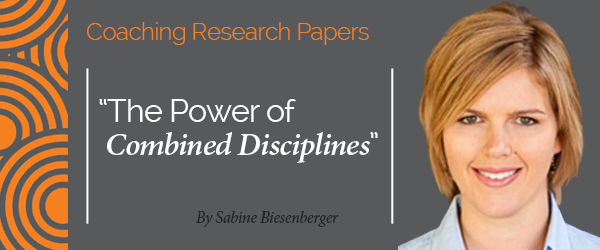Research Paper By Sabine Biesenberger
(Australia Leadership Coaching, GERMANY)
Coaching Influences
The power of combined disciplines – A transformational journey of a ‘leader in heels’ in an organisational setting
Inspired by concepts and tools from Coaching, Mentoring, Consulting, Change Management, Management & Leadership Theories, Emotional Intelligence, Neuroscience and Motivational Interviewing.
This case study describes how a consultancy leveraged concepts and tools from various coaching related disciplines to design and implement a one-year developmental ‘enhancer’ program (pilot) in an organisational setting. The focus of this study is to share the framework, the phases in more detail and the concepts and tools applied to a leadership engagement including the results achieved – along the way and in the end.
Situation
Sue was a 35-year old team leader in the supply department at an international manufacturing company. She and her team of 10 were responsible for sourcing new suppliers, evaluating existing ones and work with them on continuous improvement initiatives to ensure lower prices, better quality, innovative solutions, etc. Sue started with the company 13 years ago and she worked her way up to the team lead position due to her ongoing good performance. She had a good network within the company and was a credible and respected expert in her area. Even though she was still very passionate about work, she felt sometimes drained and overwhelmed during the day. Over the last months, her work-life balance got worse and she spent less time with her family and had nearly no ‘me-time’ to focus on her mind-body (nutrition, exercise, emotional/mental state).
Not knowing it for sure, she suspected that her team was experiencing the same ‘symptoms’ due to increased pressure; her team seemed to be less engaged. Sue had a good professional relationship with her 1- and 2-up managers and her team, however she didn’t discuss the situation and her thoughts with them. Never ending ‘time pressure’ seemed to be the status quo throughout all levels, thus Sue didn’t ‘whinge’ to waste even more time. Her confidence in herself and also her team was at a ‘5 out of 10’.
The company had undergone and will undergo incremental change to ensure its competitiveness in the market. Recently conducted engagement studies showed that moral amongst employees was neither negative nor positive, that employees felt treated ok by the company and accepted their policies. However employees had serious concerns about the future of the company due to increased competition and productivity instability. They also mentioned that structured, internal communication was not very strong as most of the news was unofficially shared during water-cooler conversations and was often based on opinionated rumours. Partners, suppliers and customers rated the service-orientation of the company as average – so neither a competitive advantage nor necessarily a ‘no-go’ company.
After cascading the results of the study, HR introduced a one-year developmental ‘enhancer’ program for interested team leads that was sponsored and supported by their managers. As both the 1- and 2-up managers saw great potential in Sue, they recommended her for the program. Not knowing what to expect and with some fears around being seen a ‘failure’ by everyone, Sue agreed to give it a shot. She knew and felt that a lot of things within her private and professional life needed to change, even though she couldn’t clearly put her finger on it yet.
High-level Overview
This section provides a high-level overview and describes the specifically developed framework including its phases. The developmental ‘enhancer’ program was supposed to run for a maximum of one year (first 6 months: phase 0-5 / second 6 months: phase 6-7), was strength-based, and encompassed the following phases:
*NB: Phase 4a feeds into Phase 4b and vice versa.
Aligned Objectives
The objectives of the developmental program were threefold; the company, the managers and the coachee had all their unique perspective of what needs to be achieved. However, it was clearly stated by HR that the objectives needed to be aligned and interrelated.
The key objectives of the company were:
In Sue’s case, the objectives of her managers for her were:
Even though the objectives broken down to an individual level were different, they supported the company’s overall objectives and gave enough space for the individual to express their immediate needs. More details on how this had been achieved are captured in the following chapters.
